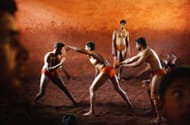
Indian men practice the three thousand year old sport known as “Kushti”, a form of wrestling, in its traditional form at the fight club Shahupuri
It was finally in September 10, 1910 that Gama faced Stanislaus Zbyszko for the John Bull Championship belt where Stanislaus was so defensive that he spent almost the entire match holding on to the mat as if his life depended on it, and the match was called a draw. A rematch was scheduled a week later but Stanislaus never showed up and the championship was awarded to Gama, thus making him the World Heavyweight Champion. Curiously, his name can no longer be found in the wrestling archives, and Frank Gotch is stated as the world champion between 1908 and 1913. Nevertheless, the win against Stanislaus led Gama to be crowned the Rustam-e-Zamana or “The Champion of the World”, a feat that even his brother Imam Baksh and the legendary Dara Singh couldn’t match. This only goes on to show the greatness of Gama.
Coming back to the tour, Gama defeated a lot many other wrestling champions in London including the European Champion and the Swedish World Champion, but his dream of defeating Frank Gotch was never fulfilled as Frank decided not to risk his champion status against the man who had slain all the giants of wrestling in London. So the tour was cut short and the wrestlers returned to India. But the Rustam-e-Hind crown still rested with Raheem Baksh and in order to win it and establish his numero uno position in the wrestling domain once and for all, Gama faced Raheem Baksh for the fourth and final time in 1911 and defeated him to finally become the Rustam-e-Hind. So now Stanislaus remained the only wrestler that Gama couldn’t defeat yet. But Stanislaus’s claim to fame was short-lived as in a match in 1928 held in Patiala, Gama defeated him in 42 seconds flat and Stanislaus left the ring red-faced in a huff.
Gama’s final professional bout came in 1929 against the Swede, Jesse Peterson and Gama gave him a sound thrashing to remain undefeated all throughout his career. Although Gama didn’t formally announce his retirement until 1952, he remained active only on paper as no wrestler dared to face him. After the partition of India in 1947, Gama shifted to Lahore, Pakistan where he spent the remaining days of his life until his death in the summer of 1963.
It is said that the only wrestler who could have defeated Gama Pehlwan was none other than his own brother, Imam Baksh Pehlwan, who was not only half a feet taller than his more acclaimed sibling, but was also hailed by experts as tactically more superior than Gama. But call it fraternal loyalty or mutual respect, but they never came face to face though Gama eventually did relinquish his Rustam-e-Hind title to his brother in a tournament in Kolhapur in which Imam Baksh destroyed Gama’s arch rival Raheem Baksh in the ring.
But the real dream match-up in wrestling would have been between Gama Pehlwan and the only other undefeated Pehlwan in the history of wrestling, the winner of the Rustam-e-Punjab and Rustam-e-Hind titles, the wrestling mammoth from India, Dara Singh. But sadly, the two belonged to different eras and hence the outcome of such a bout is all but a matter of conjecture.
So here ends the brilliant story of the life and death of Gama Pehlwan and his innumerable achievements in the ring. His physical dexterity was acknowledged by none other than Bruce Lee who closely studied and adapted many of Gama’s exercise routines, and his wrestling acumen was acknowledged by the Prince of Wales himself, who gifted Gama with a silver mace during his 1922 visit to India, the one that you will see Gama carrying in the now iconic photograph. But Gama’s era is now long gone.
Many pehlwans have since come and gone, and the world of wrestling has seen a great many revolutionary changes; but no one has ever been able to replicate what this unassuming guy, hailing from a country caught in the grip of Colonialism, achieved against all odds in that wonderful era. “The Lion of Punjab” could never be tamed and his accomplishments have become a part of wrestling folklore. But Olympus has fallen and newer and less divine wrestling Gods have taken over the world, and “The Great Gama” has given way to the lesser mortal called “The Great Khali”. But his legend will live on no matter what, because Gama was the God of wrestling and Gods never die.
